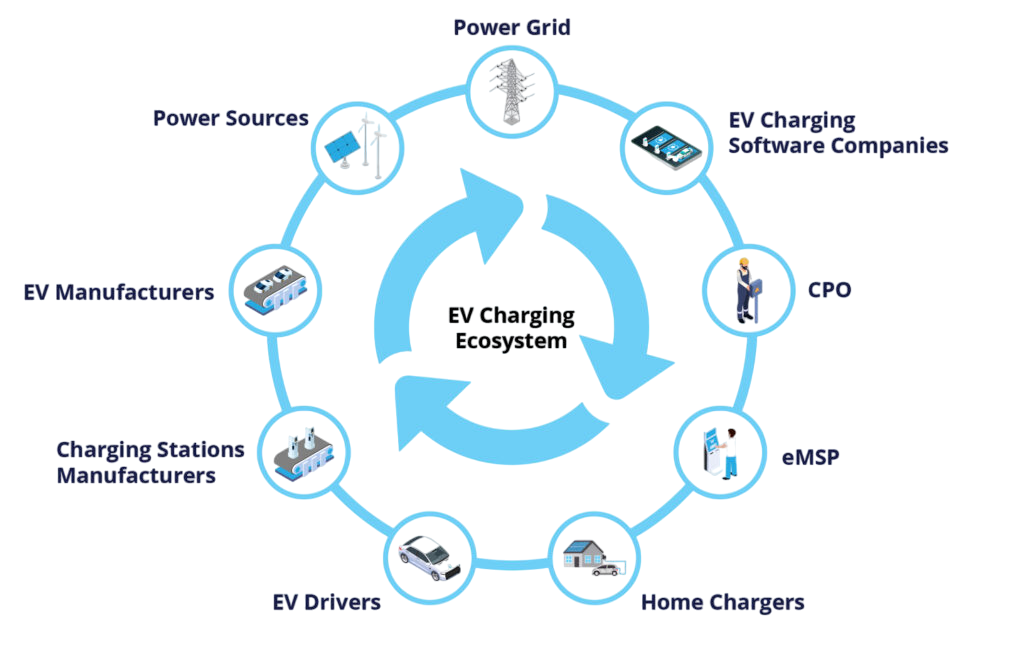
- Definition and Basics
- Types of Electric Vehicles
- Evolution of EVs
- Key Characteristics
- Major Components of an EV
- Battery Technology
- Charging Infrastructure
- EVs vs ICE Vehicles
- Environmental Benefits
- Use Cases
- Popular Models
- Future Outlook
Definition and Basics
Electric Vehicles (EVs) represent a pivotal shift in automotive engineering and environmental consciousness. Unlike traditional internal combustion engine (ICE) vehicles, EVs use electric motors powered by energy stored in rechargeable batteries. The growing need to reduce air pollution, combat climate change, and transition away from fossil fuels has significantly accelerated the adoption of EVs globally, further supported by advancements in Artificial Intelligence Training that enhance vehicle efficiency, battery management, and smart energy systems. In this document, we delve deep into EV types, history, architecture, technology, benefits, and the road ahead. Electric vehicle technology is influencing not only passenger vehicles but also buses, trucks, two-wheelers, and even aviation prototypes, demonstrating that mobility in the future will be varied, connected, and emission-free. Consumers should anticipate ongoing advancements in EVs’ range, charging speed, battery lifespan, and affordability as innovation picks up speed, making them a sensible option for a variety of transportation requirements.
Types of Electric Vehicles
There are several classifications of EVs based on their power source and functionality:
- Battery Electric Vehicles (BEVs): These are fully electric vehicles that rely solely on batteries and electric motors. There is no internal combustion engine or fuel tank.
- Plug-in Hybrid Electric Vehicles (PHEVs): These vehicles combine an ICE and an electric drivetrain. They can operate using either power source and can be charged via external electricity.
- Hybrid Electric Vehicles (HEVs): These use both a conventional engine and electric propulsion but cannot be charged externally. Instead, they rely on regenerative braking a process explained in detail in How Regenerative Braking Works in EV and the ICE to recharge the battery.
- Fuel Cell Electric Vehicles (FCEVs): These produce electricity using hydrogen fuel cells and emit only water vapor.
Each type addresses different consumer needs regarding range, cost, and driving behavior.
Evolution of Electric Vehicles
Long before gasoline engines ruled the roads, early pioneers experimented with electric power. A new era in transportation began in the early 1800s when inventors like Thomas Davenport and Robert Anderson constructed some of the earliest electric-powered carriages. EVs are not a recent invention, and understanding How Electric Vehicles Manage Speed Control is key to appreciating their advanced engineering and performance capabilities. They date back to the 19th century:

- Early 1800s: Experiments with rudimentary electric-powered transport.
- Late 1800s – Early 1900s: EVs were more popular than gasoline vehicles in cities due to their clean and quiet operation.
- 1920s: Advancements in ICE vehicles and the discovery of cheap oil reduced the demand for EVs.
- 1970s: Oil crises revived interest in alternative energy vehicles.
- 1997: The launch of the Toyota Prius marked a significant step for hybrid technology.
- 2008 Onwards: Tesla revolutionized EV performance and range with the Roadster and Model S.
- 2020s: Most major automakers have announced plans to electrify their fleets.
- Zero Emissions: Especially BEVs and FCEVs, which emit no tailpipe pollutants.
- Low Noise and Vibration: No combustion engine means quieter rides.
- Instant Torque: Electric motors deliver full torque instantly, enhancing acceleration.
- Lower Operating Costs: Reduced maintenance and lower energy costs.
- Regenerative Braking: Recharges battery during deceleration.
- Battery Pack: The heart of an EV, commonly made of lithium-ion cells, determining range and performance.
- Electric Motor: Converts electrical energy into mechanical motion.
- Inverter: Changes direct current (DC) from the battery to alternating current (AC) for the motor.
- Controller/ECU: Brain of the EV, controlling power flow and ensuring safety.
- Onboard Charger: Manages AC-to-DC charging and communicates with external charging equipment.
- Level 1 (120V AC): Slow charging; used in home environments.
- Level 2 (240V AC): Faster, used in homes and public charging stations.
- DC Fast Charging: High-powered, capable of charging an EV to 80% in under an hour. Smart and Connected Chargers. Vehicle-to-Grid (V2G): EVs supply energy back to the grid during peak demand.
- Mobile Charging Solutions: Portable battery packs and charging vans for emergency or remote locations.
- Charging Apps: Enable real-time station tracking, payment, and scheduling.
- Air Pollution Reduction: Especially in dense urban areas.
- Lower Greenhouse Gas Emissions: Particularly when charged with renewable energy.
- Noise Pollution Reduction: EVs contribute to quieter cities.
- Renewable Energy Synergy: Store excess solar/wind energy in EV batteries.
- Resource Recycling: Used EV batteries can be repurposed for stationary storage.
- Urban Mobility: Electric two-wheelers and compact cars.
- Public Transportation: E-buses, metro feeder services.
- Freight and Logistics:Electric trucks and cargo vans rely heavily on the Controller in EV to manage power delivery, optimize efficiency, and ensure smooth operation during heavy-duty transport.
- Agriculture and Industry: Electric tractors and forklifts.
- Corporate Fleets: Companies adopting EVs for CSR and cost savings.
- Tesla Model 3/Y/S/X: Benchmark for range and tech.
- Nissan Leaf: One of the most affordable and widely used.
- Tata Nexon EV: India’s top-selling electric car.
- Hyundai Ioniq 5, Kona EV: Blend of design and performance.
- Ola S1 Pro, Ather 450X: Bestsellers in the electric scooter segment.
- Limited Charging Infrastructure: Especially in rural and semi-urban areas, highlighting the need for well-planned EV Projects and Systems to expand accessibility and support widespread adoption.
- High Initial Cost: EVs are still costlier than ICE vehicles without subsidies.
- Battery Raw Material Sourcing: Cobalt and lithium mining concerns.
- End-of-Life Recycling: Lack of standard protocols for battery disposal.
- Cold Climate Performance: Battery efficiency drops in freezing conditions.
- Consumer Awareness: Myths and lack of firsthand experience deter adoption.
Ready to Get Certified in Artificial Intelligence ? Explore the Program Now Artificial Intelligence Online Training Offered By ACTE Right Now!
Key Characteristics
EVs offer several distinctive features compared to ICE vehicles:
Major Components of an Electric Vehicle
Understanding the internal architecture of EVs helps appreciate their innovation, particularly the role of Embedded Systems in Automobiles that control everything from power management to safety features.
To Explore Artificial Intelligence in Depth, Check Out Our Comprehensive Artificial Intelligence Online Training To Gain Insights From Our Experts!
Battery Technologies
The majority of contemporary EV batteries are lithium-ion, which is preferred due to its superior energy density, long lifespan, and lightweight construction. The performance, range, and general efficiency of an electric vehicle are all greatly influenced by these batteries. How these batteries work and sustain their performance is explained by a few key ideas. The battery’s current state, represented as a percentage of its entire capacity, is known as the State of Charge (SOC), an important concept to understand What is Electric Vehicle Fleet management and optimization. The State of Health (SOH), on the other hand, gauges how much a battery has deteriorated over time in comparison to its initial state, which affects how long it can function effectively. Future battery developments could further increase the sustainability and efficiency of electric vehicles. Compared to existing lithium-ion technology, solid-state batteries provide a higher energy density, quicker charging periods, and enhanced safety, making them the subject of intense research. Furthermore, new chemistries like metal-air and lithium-sulfur batteries are being investigated for their potential to provide remarkable performance and long range, opening the door for the next wave of electric mobility.
Charging Infrastructure
A strong and dependable charging infrastructure is essential to the broad use of electric vehicles. It would be difficult for even the most sophisticated electric cars to satisfy consumer demands for accessibility and convenience without a well-functioning network of chargers. Developing quick, intelligent, and widely accessible charging systems has become a major concern for governments, manufacturers, and energy suppliers as the global EV industry grows, with Artificial Intelligence Training playing a key role in optimizing charging efficiency, energy distribution, and predictive maintenance. Robust charging infrastructure is essential for EV adoption. There are different charging levels:

Environmental Impact
EVs bring about substantial environmental benefits, which are further enhanced by efficient Electric Vehicle Charging infrastructure that supports clean energy use and reduces overall carbon emissions.
EVs vs ICE Vehicles
| Feature | EVs | ICE Vehicles |
|---|---|---|
| Emissions | Zero (tailpipe) | High CO2, NOx, particulates |
| Fuel Cost | Low (electricity) | High (petrol/diesel) |
| Maintenance | Minimal (no oil/filter change) | Frequent servicing |
| Acceleration | Instant torque | Lag due to combustion |
| Noise | Silent | Engine and exhaust noise |
| Efficiency | >85% | ~25-30% |
Looking to Master Machine Learning? Discover the Artificial Intelligence Expert Masters Program Training Course Available at ACTE Now!
Use Cases of EVs
Preparing for Artificial Intelligence Job Interviews? Have a Look at Our Blog on Artificial Intelligence Interview Questions and Answers To Ace Your Interview!
Popular EV Models Worldwide
Challenges in EV Adoption
Despite progress, EVs face some roadblocks:
Future Outlook
Electric Vehicles are no longer a futuristic concept they are a global reality. As battery technology matures, costs reduce, and governments push for cleaner alternatives, EVs are poised to dominate the roads. By 2030, many nations aim to phase out ICE vehicle sales, and automakers are already investing billions in EV platforms. Whether for environmental reasons, operational savings, or sheer performance, EVs represent the future of mobility, enhanced by Artificial Intelligence Training that optimizes energy use, vehicle performance, and smart driving systems. With continued innovation, education, and ecosystem development, the transition to electric transportation will be transformative for both the economy and the planet. Additionally, a cleaner, more sustainable ecology will be shaped by the cooperation between the automotive and renewable energy sectors. A circular energy economy will be created by solar-powered charging stations, vehicle-to-grid (V2G) technology, and second-life uses for spent batteries, which will reduce waste and increase efficiency.




